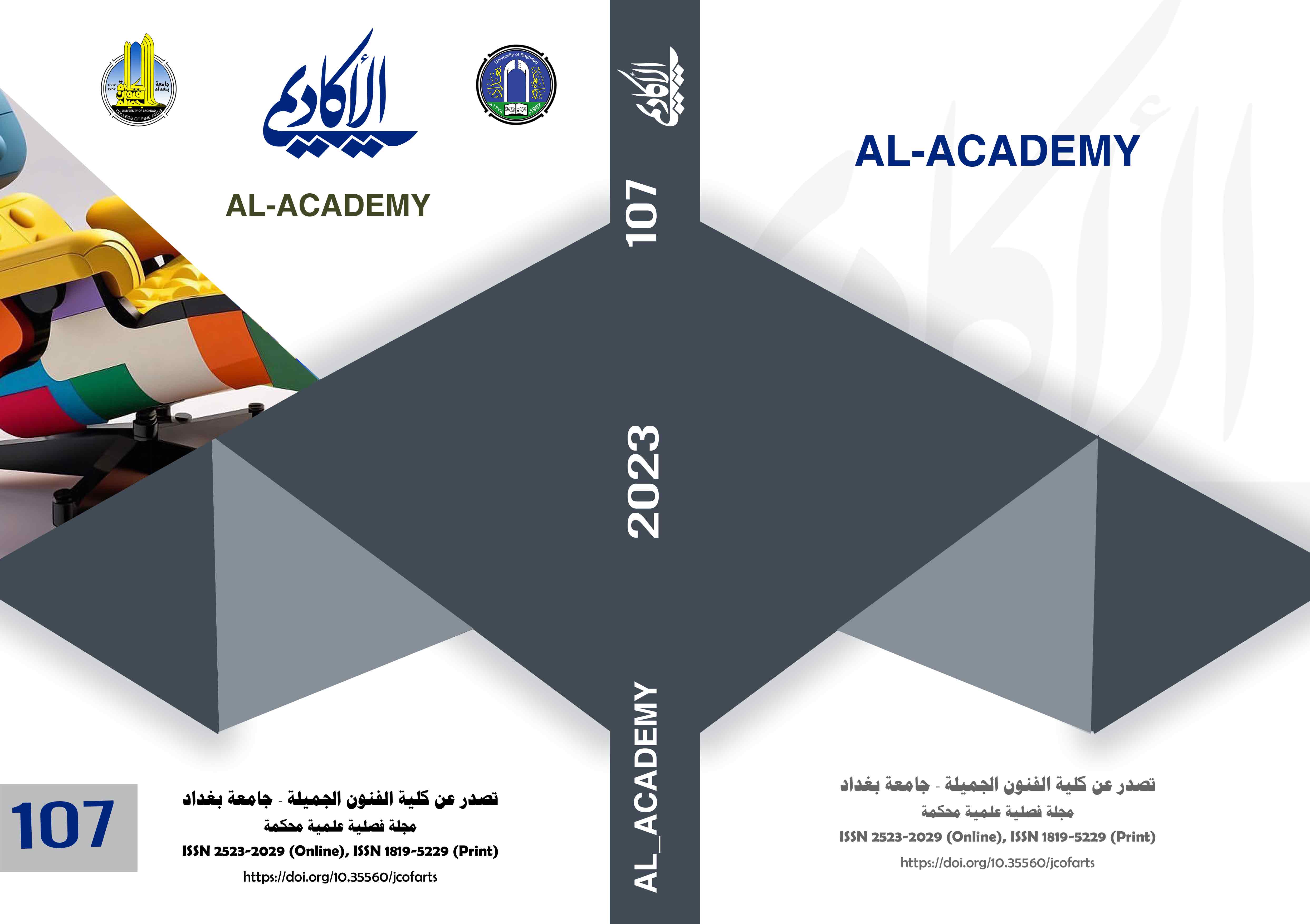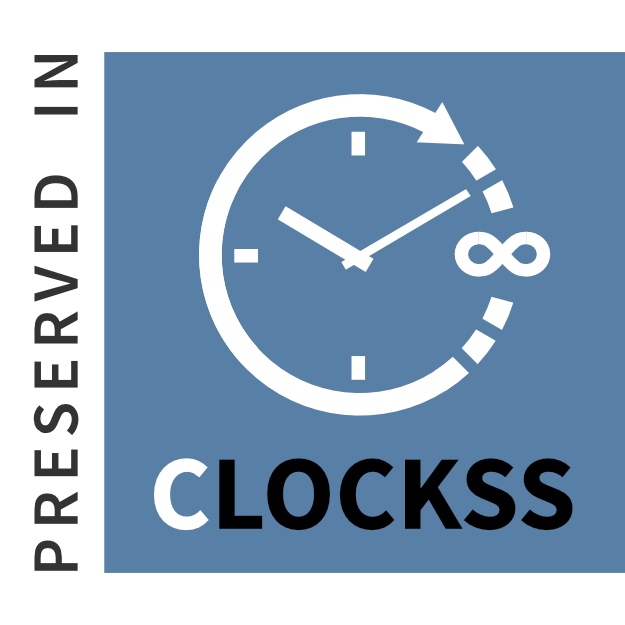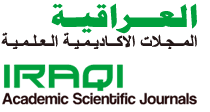The decorative structure in the calligraphic painting
DOI:
https://doi.org/10.35560/jcofarts107/129-146Keywords:
decorative, structure, calligraphic paintingAbstract
The decoration structure in calligraphy painting is one of the variables that characterized the structure of the calligraphic composition due to the artistic, aesthetic and expressive properties of the letters of the Arabic calligraphy, which are represented by flexibility, compliance and the ability to form. Therefore, the researcher defined his problem by asking the following question: What is the decorative structure in the calligraphic painting? The study aimed to reveal the structure of the ornamentation in the calligraphy painting, while the researcher dealt with in the second chapter three sections, the first (the ornamental concept and meaning) and the second topic (the structural characteristics of the Arabic letter in the calligraphic calligraphy painting) and the third topic (the aesthetic foundations in the calligraphic calligraphy painting) and then Indicators of the theoretical framework and previous studies, while the third chapter dealt with the research procedures, where the researcher adopted the descriptive analytical approach of the research community and sampled it by 10%. (The ability of the Arabic letter and its response to formation contributed by employing it to produce calligraphic lettering paintings with lunar structures) and then recommendations to benefit from the results and findings of the research to support researchers, scholars and specialized colleges, and the researcher suggested a study (the formal significance of the trapping effect in the lettering calligraphy painting).
References
Abdel-Fattah, R. (1973). Formation in the fine arts. Cairo: Arab Renaissance House.
Abdalkarem Husaen, A. (2020). Formal Formation and its Semantic Projections in the Design Interior Spaces of the Daily newspapers Buildings: Araa Abdalkarem Husaen . Al-Academy Journal, (98), 325–342. https://doi.org/10.35560/jcofarts98/325-342
Al-Azzawi, H. R. (2004). Gravity in the structure of magazine designs. Baghdad: College of Arts, University of Baghdad.
Al-Bahnassy, A. (1974). Theoretical studies in Arab art. Cairo: Egyptian General Book Authority.
Al-Bahnasy, A. (1995). Dictionary of Arabic calligraphy terms and calligraphers. Beirut: Lebanon Library.
Al-Farahidi, K. b. (2003). Al-Ain. Beirut: Scientific Books House.
Al-Husseini, I. A. (1996). Technical training according to the basics of design. Baghdad: College of Arts, University of Baghdad.
Al-Obaidi, M. J. (2004). Design relationships in linear painting. . Baghdad: College of Fine Arts, University of Baghdad.
Al-Zuhairi, A. A. (2014). Design variations in calligraphy painting. Baghdad: College of Fine Arts, University of Baghdad.
Daoud, A. R. (1996). Building rules for content semantics in linear formations. Baghdad: College of Arts, University of Baghdad.
Haider, N. A. (1996). Analysis and composition in contemporary Iraqi painting. Baghdad: College of Arts, University of Baghdad.
Herbert, R. (1983). Art presence. Baghdad: Ministry of Culture and Information.
Internet. (n.d.). The comprehensive dictionary of meanings. Retrieved from www.almaany.com
Kazem, N. M. (2004). Installation systems in the Assyrian plastic arts and their reflections on contemporary Iraqi painting. Baghdad: College of Arts, University of Baghdad.
K. Yaser, A. . (2022). Experimentation in the works of the artist Muhammad Al-Kinani" an anaylytical study". Al-Academy Journal, (103), 225–240. https://doi.org/10.35560/jcofarts103/225-240
kadim sibahi,&hassan 2022) space Efficiency in the Arabic calligraphy panel.AL -Academy Journal ( 104),73-90 https://doi.org/10.35560/jcofarts104/73-90
kadim sibahi,&hassan 2022) space Efficiency in the Arabic calligraphy
https://doi.org/10.35560/jcofarts104/73-panel90 panel . Al .Academy Journal(104), 73-90
linguistic, G. o. (1989). Basic arabic dictionary. Egypt: Arab Organization for Education, Culture and Media.
Maalouf, L. (1986). Al-Munajjid in language and media. Lebanon: Dar Al Sharq.
Marie, A. (1994). The simile in the letter in Islamic literature. Fikrun wa Fann magazine , Albert Taylor Publications.
Masoud, G. (1992). Al-Raed Dictionary. The House of Science for Millions.
Nathan, N. (1987). The dialogue of vision is an introduction to artistic taste and aesthetic experience. Baghdad: Dar Al-Mamoun.
Nobler, N. (1987). Vision Dialogue, an introduction to art tasting and aesthetic experience. Baghdad: Dar Al-Mamoun for translation and publishing.
Okasha, T. (1981). Aesthetic values in Islamic architecture. Cairo: Dar Almaearif.
Qutb, M. (1983). Islamic art curriculum. Beirut: Dar Alshuruq.
radhy Ghadheb, M., & Abdul Hussein Mohsen, A. (2020). expressive modulation in calligraphic configurations: Mohammed radhy GhadhebAli Abdul Hussein Mohsen, . Al-Academy Journal, (96), 325–340. https://doi.org/10.35560/jcofarts96/325-340
Saleh, Q. H. (1981). Creativity in art. Baghdad: Dar Al Rasheed.
Saliba, J. (1982). Philosophical Dictionary. Lebanon: Lebanese Book House.
Shahwan, M. M.-M. (2019). Letters as a plastic element in modern Arab art. Journal of Educational Sciences, South Valley University, College of Education.
Saad Adnan Al-Hindawi, A. (2022). color methodology to Re-reading the musical notes. Al-Academy, (106), 39–58. https://doi.org/10.35560/jcofarts106/39-58
Faisal Mosa Al Nawab, R. (2022). The art of adornment and make-up in the ancient civilizations of Mesopotamia and the old country of Yemen as a model. Al-Academy, (106), 149–166. https://doi.org/10.35560/jcofarts106/149-166
jirjis Nehme, A., & Naima Obaid, A. (2022). Visual effects in contemporary animation design. Al-Academy, (106), 407–430. https://doi.org/10.35560/jcofarts106/407-430
behnam yashoa, frdos . (2022). The dialectic of religious and worldly reality in Maher Harbi’s drawings. Al-Academy, (104), 5–18. https://doi.org/10.35560/jcofarts104/5-18
Nafal Mahdi, H. . (2022). The prospects ability of contemporary epistemology for signification internal construction of plastic artwork. Al-Academy, (104), 173–190. https://doi.org/10.35560/jcofarts104/173-190
ELMAHI, Z. (2022). Art as a therapy to relieve symptoms of Attention Deficit/Hyperactivity Disorder (ADHD), in children. Al-Academy, (106), 167–186. https://doi.org/10.35560/jcofarts106/167-186
bint Mohammad AlMutairi, S., & bint Ayed Alharbi , R. (2022). Inventory of Saudi youth trends towards choosing fashion accessories. Al-Academy, (106), 205–230. https://doi.org/10.35560/jcofarts106/205-230
Saleh Moraished, L., & Saleh Al-Saleh, M. (2022). The Relationship Between Using Diverse Materials to the Intellectual Context’s in the Art of Contemporary Ceramic. Al-Academy, (106), 253–270. https://doi.org/10.35560/jcofarts106/253-270
mohammed Alamri, M., & bint Mansour Abdul Aziz aljadid, M. (2022). Printmaking Techniques to Enable People with Visual Impairment to Taste Print Artworks. Al-Academy, (106), 297–318. https://doi.org/10.35560/jcofarts106/297-318
Gharsan Alshehri, H. . (2022). Role Of the Interactive Public Sculpture in Increasing Physical Activity . Al-Academy, (105), 57–80. https://doi.org/10.35560/jcofarts105/57-80
Ibrahim Alhulwah, N. ., Saud Alrasheed, E. ., & Almokhtar Lahyani, S. . (2022). The semiotics of the visual image of women in the discourse of empowerment, Saudi Arabia Kingdom as a model. Al-Academy, (103), 25–42. https://doi.org/10.35560/jcofarts103/25-42
Ahmad allaoui, L. . (2022). Textual thresholds and its Aesthetic in history: "Mamo Zain" by its author, the famous Kurdish poet Sheikh Ahmad Al-Khani, deceased (1118 AH / 707 AD), translated by Sheikh Dr. Muhammad Saeed Ramadan al-Bouti. Research on the connotation and manifestations of interconnection. Al-Academy, (103), 73–92. https://doi.org/10.35560/jcofarts103/73-92
mohamed Dammak, K. (2022). Transformations of the body from traditional expression to subjectivity : Marina Abramivic as a model. Al-Academy, (103), 149–164. https://doi.org/10.35560/jcofarts103/149-164
shafee, wafa H., & aboabat, A. A. (2021). Recycling waste toys to accessories suggested uniform for educational units in kindergarten stages. Al-Academy, (102), 63–80. https://doi.org/10.35560/jcofarts102/63-80
Ebraheem Mongy, Y. ., Amer Al-Hajri, S. ., & Al Mardhoof Al Saadi, N. . (2021). Inspiring heritage and symbols of local identity in contemporary Omani Graphic Art. Al-Academy, (102), 81–104. https://doi.org/10.35560/jcofarts102/81-104
Nasser AL Nahari , N. . (2021). The Role of Contemporary Interactive Art Works Economically and Culturally "An Analytical Study". Al-Academy, (102), 123–144. https://doi.org/10.35560/jcofarts102/123-144
Kalied Talib Alsamurai, A. . (2021). The communicative education of fine arts in the COVID-19 crisis and its manifestations in the modernization of the works of the Iraqi painter "Nabil Ali as a model". Al-Academy, (102), 207–222. https://doi.org/10.35560/jcofarts102/207-222
Daryanavard (al-ghaisi), Z., Balavi, R., & M. Bataineh, A. (2021). The Communicative Functions in The Speech of The UAE National Anthem in The Light of The Eloquence of The Audience. Al-Academy, (101), 145–156. https://doi.org/10.35560/jcofarts101/145-156
Abdullah Al-Qudairi, T. (2021). Designing Clothes that Meet the Functional and Aesthetic Needs of Children with Hip Dislocation. Al-Academy, (101), 157–184. https://doi.org/10.35560/jcofarts101/157-184
Abdulaziz Alfadda, A. (2021). Utilization of Design Principles of Nature in Innovating Contemporary Metal Products. Al-Academy, (101), 203–226. https://doi.org/10.35560/jcofarts101/203-226
Daryanavard, Z., Balavi, R., & Khezri, A. (2021). Semantic functions of repetitive synthesis in Adnan al-Sayegh’s poetry. Al-Academy, (100), 233–246. https://doi.org/10.35560/jcofarts100/233-246
Hassan Abu Hasna, R. (2021). The Utilization of Arabic Calligraphy to Inspire Modern Arabic Type Designs. Al-Academy, (100), 277–304. https://doi.org/10.35560/jcofarts100/277-304
Aldaawani, R. F. (2021). The semiotic of the Islamic blazon - a related analytical study between the Islamic blazon and its publicity message. Al-Academy, (100), 319–336. https://doi.org/10.35560/jcofarts100/319-336
Wafa Hassan, S., & Marram Zaid, A.-H. (2021). Sustainability by recycling palm waste in designing women’s belts. Al-Academy, (100), 337–356. https://doi.org/10.35560/jcofarts100/337-356
Kazem Odeh, R., & Khalaf Hussain, S. (2021). The effectiveness of media communication and its problems in the contemporary theatrical presentation. Al-Academy, (99), 155–168. https://doi.org/10.35560/jcofarts99/155-168
Saud Al-Hazza, H. (2021). Study of the participation of Saudi women in official visual arts exhibitions "Contemporary Saudi Art Exhibition as an Example". Al-Academy, (99), 311–328. https://doi.org/10.35560/jcofarts99/311-328
Ali Ahmed Abdel Rahman, R. (2021). Making use of economical design techniques and materials in implementing cosmetic supplements to the interior spaces of the dwelling. Al-Academy, (99), 329–348. https://doi.org/10.35560/jcofarts99/329-348
Al Saadi, N. (2021). Variables related to the performance styles of batik art to achieve linear tactile effects in the printmaking. Al-Academy, (99), 349–364. https://doi.org/10.35560/jcofarts99/349-364
Saad Algarni, M. (2021). Virtual Art Exhibitions In Times Of The Corona Pandemic. Al-Academy, (99), 441–480. https://doi.org/10.35560/jcofarts99/441-480
Abduljabbar AlEssa, A. (2020). Simulation As One Of The Tools Of Visual Thinking And Its Effect On Developing Drawing And Design Skills To Produce Innovative Artworks. Al-Academy, (98), 235–254. https://doi.org/10.35560/jcofarts98/235-254
Mohammed Al-Mutairi, S., Yousef Altwaijri, B., Yousef Al-Ali, R., & Abdul Hakim Almoqrin, S. (2020). Designing an E-marketing Website for Sustainable Fashion. Al-Academy, (98), 271–286. https://doi.org/10.35560/jcofarts98/271-286
A.A. FEDA, L. (2020). GIRL’S TRADITIONA COSTUME IN MAKKAH AL MUKARRAMAH _ KINGDOM OF SAUDI ARABIA”. Al-Academy, (98), 305–324. https://doi.org/10.35560/jcofarts98/305-324
Abdulhafeez, N. (2020). Novel Coronavirus Pandemic as it is Expressed by Children in Their Drawings On-line: An Analytical Study. Al-Academy, (98), 413–434. https://doi.org/10.35560/jcofarts98/413-434
Almamari, B. M. (2020). Appearance and Decay of Split-brain Theory to Explain Human Artistic Activity: A Historical Review. Al-Academy, (97), 261–270. https://doi.org/10.35560/jcofarts97/261-270
Abdulhafeez, N. (2020). The Philosophy of Beauty and Aesthetic Tasting in the Story of Yusuf, peace be upon him, with the Al-Azeez’s Wife in light of the sayings of Ancient Philosophers and Modernists. Al-Academy, (97), 241–260. https://doi.org/10.35560/jcofarts97/241-260
O Alzahrani, M. (2020). The Image of Women in Arab Media Advertisements. Al-Academy, (97), 299–320. https://doi.org/10.35560/jcofarts97/299-320
Abdulghaffar Feda, L. (2020). Recycling evening dresses into modern dresses with traditional features. Al-Academy, (97), 321–342. https://doi.org/10.35560/jcofarts97/321-342
Saud Alrasheed, E. (2020). Digitization is a contemporary reality and its importance in the Saudi plastic arts. Al-Academy, (96), 213–228. https://doi.org/10.35560/jcofarts96/213-228
Mohammed Alamri, M. (2020). Inspiration Of Typed Paintings From Folk Architecture In Asir Region. Al-Academy, (96), 229–250. https://doi.org/10.35560/jcofarts96/229-250
Murshed Alharbi, M., Alahmad, H., & Alsenan, M. (2020). Saudi society’s trends towards visiting museums and art galleries. Al-Academy, (96), 251–272. https://doi.org/10.35560/jcofarts96/251-272
kadim oda, russil, & fuad fadhel, L. (2020). Techniques of Acting Performance in Fantasy Theatrical Show. Al-Academy, (95), 5–18. https://doi.org/10.35560/jcofarts95/5-18
Mohammed taleb al dweik, S., abu taleb, S., & saber, M. (2020). The Role of the Passive Conditioning in Achieving Thermal Comfort in Temporary Hotel Units. Al-Academy, (95), 243–272. https://doi.org/10.35560/jcofarts95/243-272
Ibrahim Bin Hamdan, N. (2019). Creativity in the Draping on the mannequin of Young Girls Victorian Fashion between 1860-1890. Al-Academy, (94), 73–96. https://doi.org/10.35560/jcofarts94/73-96
Nassar Alajaji, T., & Abdulazez Almogren, H. (2019). The Effect of The Illustration Program on Fashion Design Inspired by Historical Costumes:. Al-Academy, (94), 97–114. https://doi.org/10.35560/jcofarts94/97-114
Nassar Alajaji, T., & Mohammed Alfulaij, W. (2019). Revival of the Heritage Using Porcelain Units Inspired by Traditional Sadou Decoration and Kufic Calligraphy in Fashion Design. Al-Academy, (92), 253–270. https://doi.org/10.35560/jcofarts92/253-270
Nawi, K. (2019). Time in the Cinema.The Two Films (The Knife and The Deceived) -A Model. Al-Academy, (91), 49–64. https://doi.org/10.35560/jcofarts91/49-64
alsayed Mustafa jawad ahmed, B. (2016). The Instagram from a media tool to a marketing tool. Al-Academy, (74), 195–212. https://doi.org/10.35560/jcofarts74/195-212
Khaled Taleb Al Samurai, A. (2018). The educational means used by teachers of art education in primary schools. Al-Academy, (89), 229–240. https://doi.org/10.35560/jcofarts89/229-240
Jassem Mohammed, N., & Taha yaseen, E. (2017). Structural Systems In The Design Of World Magazine Covers. Al-Academy, (86), 149–164. https://doi.org/10.35560/jcofarts86/149-164
al-Khalidi, A. S. (2017). The reality of interior design of Sharjah mosques and the possibility of development - selected models. Al-Academy, (83), 247–267. https://doi.org/10.35560/jcofarts83/247-267
kadim oda, R. (2016). Actor performance features in the types of theatrical silent. Al-Academy, (79), 225–238. https://doi.org/10.35560/jcofarts79/225-238
kadim oda, R. (2016). Indicative coding of the actor’s performance in the Iraqi theater show. Al-Academy, (77), 63–74. https://doi.org/10.35560/jcofarts77/63-74
Downloads
Published
Issue
Section
License
Copyright (c) 2023 Hussein Ali abbas

This work is licensed under a Creative Commons Attribution 4.0 International License.













